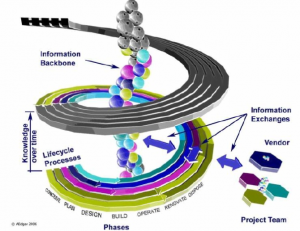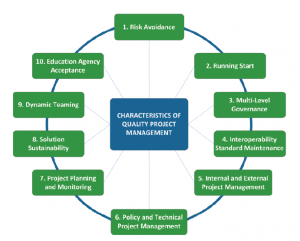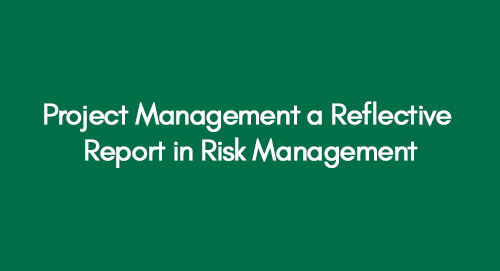
549470 – Project Management, Undergraduate, Coursework
February 6, 2021
Tropical Architecture Movement in West Africa
February 13, 2021Introduction
The increasing expectation of efficient project management techniques around the globe has influenced the stakeholders to develop methodologies that can enhance the quality and performance of any project. Through deployment of integrated technological applications and activities, various tools have evolved in past few years. Further research is progressing towards the development of innovative project management techniques.
Project management is an extremely important tool that ensures successful planning, application and commission of any project. The research completed in the last many decades has provided detailed theories, approached and methods that be adopted for a successful management of projects. This report has been prepared to acquire understanding of project management theory and review their implications in the industry.
Various research articles, books, journals, case studies and reports have been reviewed in this paper, analyses of which have been presented in this report. Furthermore, a reflective assessment of my understanding has also been presented in this report. Furthermore, the details of the leanings from the literature review have been outlined, providing a brief description of the recent informative articles and papers.
Literature Review
Much research has been completed in the last many decades on the project management theory and tools that can be employed to ensure successful completion of projects. Project management is a process which allows completion of the activities in planned and controlled way, through the means of constraints identification while fulfilling financial as well as technical requirements. This process provides support in maintaining various parameters of the projects under control, such as time, costs, safety, risks, engineering requirements etc. The process aims for optimum coordination at all levels.
The process of communicating, managing and presenting data in an electronic form, which may also referred as interoperability, hold pivotal importance for any industry. This is achieved through utilization of various tools that have been developed by researchers and specialist around the globe. These include the multi-dimensional simulation and visualization models and computer aided drafting and design programs.
It enables the management teams to gain access to detailed real time information with respect to the project requirements. This includes detailed such a primary and secondary data, secondary, operational updates, time spans and wok plans, depending on the specific tool chooses to be used in the project. It acts a bridge between design and application.
One of the most widely applied programs is the Building Information Modelling (BIM). The BIM enables generation and management of applicable data during the course of life cycle of the project. The primary parameters that this programs is able to process includes 3D modelling, graphical analyses, spatial and properties and risk analyses etc. Other tools such as the 3D CAD (Virtual Construction, 3 Dimensional AutoCAD), IS (Information System), CIC (Computer Information Construction) and PRIMAVERA etc are also being used increasingly by a large number of personnel in the civil engineering industry (Lee et al. 2006).

Figure 1: Building Information Modeling Standard (Source: NIBS, 2006)
While various small scale projects are can be managed without the utilization of professional and advanced tools/software, the large scale projects involve various engineering requirements such as risk assessments, modelling, safety consideration, project scheduling, human resource management, material and other resource management, commissioning and many other aspects. Therefore such projects required application of IT management tools such as; the latest versions of ASL and BiSL.
These IT management domains include BIM, Application Services and Products Management and Infrastructure Services and Products Management. The report prepared by Machteld Meijer and René Sieders in 2012 provided detailed analysed on the misconceptions and misunderstandings regarding the ASL and BiSL, and provided answers to various questions related to these frameworks.
Project Manager also uses techniques such as critical path methodology, arrow method and the project network technique to ensure reliable and efficient pre project planning. Failures of Project Management may result from various reasons including lack of support from various parts of the organisation, poor decision making, lack of communication, legal limitations, and inability to estimate correct time spans (Jung and Gibson, 1999).
The safety planning process can be executed through application of BIM via visualizing the 4D modelling, which integrates the execution schedule of safety planning with the 3D model. In an effort to improve the safety planning process, Bansal in 2010, recommended utilization of Geographic Information Systems (GIS) along with the 3D model, topography and project schedule in the same environment. The proposed method facilitated an easier presentation of the sequence of construction. It further provided support in prediction of activities or localities where the risk of potential accidents is higher. The effective and rapid development of a safe construction sequence is considered to enhance the collaboration between various teams of the project (Bansal, 2010).
The various features of the civil/construction industry have utilized the concept of project management in building procurement. Various engineering projects have been successfully accomplished through adaptation of the project management technique, and the fundamental causes of these have been presented by the research complete in 2014 by Al Fariedi. The research incorporated the views of engineers, architects, consultants and project managers from various organisations. The results demonstrated that the parameters which greatly influence the project management includes project risk management, project governance at all levels, the higher level of interoperability standard maintenance, effective policy developments, technical planning, communication between all the stakeholders, sustainability enhancements, activity monitoring, in time completion of deliverables and education acceptance.
All these parameters can be defined in one major term of “Characteristics of Quality Project Management”. It is important to note that the risk management in the quality project management undertakes a proven methodology of risk management, which indentifies all the factors associated with risk and a follows for a continual process to track and trouble shoot these risk during the project life cycle.

Figure 2: Characteristics of Quality Project Management (source: Al Freidi, 2014)
The project managers also consider various fundamental techniques such as project networking, arrow methods as well as methodology of critical path to ensure optimum project planning. Through research, it was observed that in spite of the fact that many improvements have occurred in the last many years in the field of project management tools and techniques, a considerable number of projects have still failed. This can be due to the lack of poor decision making, lack of communication, lack of support within the organisation groups, legal or financial limitations and/or through ineffective scheduling of activities of the project (Zekic and Samarzija, 2012).
A very useful and informative paper was published in the project management journal which presented a detailed review on the possible approaches that can be utilized for an early detection and warning signals in projects. In order to indentify the early warning signs, this research provided detailed analyses on various early warning detection approaches, such as interface management proposed in 1988 by Cleland and Morris, which the project managers and other key stake holder can utilize (Cleland and Morris,1988).
The selection of the approach is of course based on the project in hand, its organisation, implementation context, type of culture and the project environment. While reviewing the literature, it was observed that all the approaches have their own pros and cons, and the project management has to be consider various aspects of the project before adopting to follow a certain approach; to be able to gain early warning signs during the execution of a certain phase of the project, and to ensure the preventive action are taken (Kazemi, Andersen and Krane, 2013).
Similarly, project risk management is another key discipline and it has to be considered while undertaking project management. The process of project risk management involves criterion in which choices have to be made by the project management in terms of characterization of relevant information, weather a certain aspect can be deemed as irrelevant or not. This is sometimes be referenced as deliberate ignorance in project risk management.
The research conducted by Kutsch and Hall (2009) suggested that it is important to deal with the term “irrelevance” in project management through a clearly defined mechanism. This mechanism must be able to effectively manage the relevance of any choice, while ensuring the priorities are set in accordance with the requirement of optimal project risk management.
The organisations that are involved in multi project environments must consider the ‘risk management’ as more critical. Aritua et al. (2010) provided empirical evidence of the various risks that are commonly associated with the UK public sector working programmes. Primarily, the risks are linked with revision in policies of the government, aspirations of stakeholders, and the requirements of multi-project procurement processes. An informative decision making process has to be adopted to ensure that the any risk issue is resolved on priority. From the literature review, it was observed that there is a need to distinguish the project and programmes with respect to independent management functions in the project environment.
The governance structure also plays a very influential role on the temporary organisations. It is also important to understand how the ethical issues faced by such organisation influence their managers in terms of their response. Reviewing the literature, it was observed that the project managers are encountered with optimization, transparency, relationship issues, and various other types of ethical issues. The manager’s response to these ethical issues can vary with the structure of governance, their own ability to resolve the ethical issues, and implication of trust between the key stakeholders.
The research completed by Muller et al. (2014) suggest that effective design of the governance structure can help the project managers to deal with various types of ethical issues. As an example, the trust between the project stakeholders as well as between the manager and governance structure can be improved through adjusting paradigm of governance towards a more stakeholder-oriented environment. These processes can effectively result in reduction of transaction costs, as well as in reduction of the project’s optimization issues. Hernandez (2012) work on this topic outlined a pathway through which the governance paradigm can be shifted and the level of trust can be consequently enhanced.
Reflective assessment
The recent developments efficient project management techniques have revolutionized the Civil Engineering industry. Multiple methods have developed which has offered various opportunities as well as challenges in project management. This progression in science and technology have put considerable pressure on the stake holders to utilize these tools in an effective way, in order to ensure that the resources are utilized efficiently, and the designing as well engineering processes are accomplished in way that produces desirable results of the projects.
While review the literature related to project management and risk management, and engagement of group activities undertaken as part of the module, it was observed that the practice of project management is an extremely useful technique and it can employed to address various project requirements. The process of project management simplifies the problems by reducing, and in some cases eliminating the complexities while improving the quality of the work. Furthermore, project management utilizes state of the art information technology tools which engineers methodologies to be applied in order to achieve the objectives of the project.
Successful implication of project management helps in organizing useful resources, materials and data/information, thereby reducing the chances of failure. The expertise employed in the process ensures execution of successful as well as safe planning and scheduling of projects.
Although the computer aided programs provide support in the facilitation in various aspects of the projects, the actual benefit of these programs can only be obtained through effective collaboration and integrated design and planning during the early stages of the project. Any fragmentation processes can be eliminated through efficient planning while improving the management activities as well decision making during the course of the project.
The results these processes of project management are able to achieve are quite impressive, as this improves the work flows, supply chain management, data accuracy, safe scheduling, organisation behaviour and managerial performances. Furthermore, application of effective management and tools provides support in eliminating conflicts which occur between the planning and implication stages of the project. It has also been reported to reduce the chances of project failures as the management teams can works towards a an environment that best suits their organisation, while ensuring any warning signs are received in case of a serious risk.
References
- Al Freidi, S.A., (2014). Determinants of the Best Practices for Successful Project Management
- Aritua, B., Smith, N.J. and Bower, D (2010). What risks are common to or amplified in programmes: Evidence from UK public sector infrastructure schemes. International Journal of Project Management 303–312
- Bansal, V.K., (2010). Application of geographic information systems in constructionsafety planning
- Cleland, D., & Morris, P. W. G. (1988). Project management handbook (2nded.). Hoboken, NJ: John Wiley & Sons.
- Gareis, R., Huemann, M., & Martinuzzi, A. (2013). Project management and sustainable development principles. Newtown Square, PA: Project Management Institute.
- Heizer, J. and Render, B., (2004). Principles of operations management, 5th Upper Saddle River, N.J; [Great Britain]. Available online at: http://trove.nla.gov.au/work/7299479.
- Hernandez, M., (2012). Toward an understanding of the psychology of stewardship. Academy of Management Review, 37(2)
- Jung, Y. and Gibson G. E. Jr., (1999). Planning for computer integrated Journal of Computing in Civil Engineering, ASCE 13, 4
- Kazemi, S.H., Andersen, B. And Krane, H.P., (2013). A Review on Possible Approaches for Detecting Early Warning Signs in Projects, Project Management Journal, Vol. 44, No. 5, 55–69
- Kutsch, E., and Hall, M., (2009). Deliberate ignorance in project risk management. International Journal of Project Management 245–255.
- Lee, G., Sacks R., and Eastman, C. M. (2006). Specifying parametric building object behaviour (BOB) for a building information modelling system.
- Muller, R., Tuner, R., Anderson, E.S, Shao, J. And Kvalnes, O., (2014). Ethics, Trust, and Governance in Temporary Organizations Project Management Journal, Vol. 45, No. 4, 39–54
- NIBS (2006). Update on the National Building Information Modelling Standard. Proceeding on The 3rd National Congress on Digital Collaboration in the Building Industry.
- Nikander, I. O. (2002). Early warnings: A phenomenon in project management
- Zekic, Z. and Samarzija, L., (2012). Project Management of Dynamic Optimization of Business Performance. Available online at: http://ccsenet.org/journal/index.php/ibr/article/view/21971
Get 3+ Free Dissertation Topics within 24 hours?

























